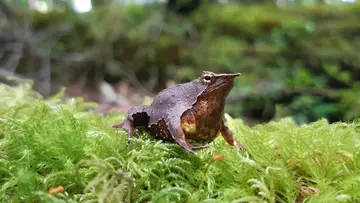
Andrew Cunningham
Deputy Director of Science
ZSL’s Deputy Director of Science, Professor Andrew Cunningham describes how the charismatic Darwin’s frog could hold crucial clues to understanding how different frog populations respond to amphibian chytridiomycosis - defined as the worst infectious disease ever recorded in vertebrates.
The Southern Darwin’s frog (Rhinoderma darwinii) is an iconic amphibian species from South America in which the male gets pregnant and which is named after Charles Darwin, who first described it.
Unfortunately, this species is threatened by the fungal disease, amphibian chytridiomycosis, which has been shown to cause population declines and extirpations across much of the Southern Darwin’s frog’s home range.
A deadly disease
The fungus that causes amphibian chytridiomycosis, and which goes by the scientific name of “Batrachochytrium dendrobatidis” (or Bd for short), has been spread around the globe by human activities and has already caused population declines of over 500 species of amphibian and the total extinction of at least 90 species world-wide, probably including the Northern Darwin’s frog (Rhinoderma rufum), which was the only other terrestrial vertebrate in which males carry and nourish the developing young internally.
New observations
In a new study published today and led by Andrés Valenzuela-Sánchez of the Ranita de Darwin NGO, and co-authored by me, as well as other experts in Chile; we found that not all frog populations respond in the same way to chytridiomycosis.
The study included observations of more than 1,000 individually-identifiable Darwin’s frogs over seven years across four intensively-studied populations: two infected and two uninfected. Over this period, the populations underwent different fates.

In one of the populations positive for chytridiomycosis, the population decreased in size during the study period due to increased mortality rates caused by the disease.
In the other disease-positive population, however, the male frogs responded to the infection by producing more tadpoles, and by reproducing more frequently, than those in populations without the infection.
This led to a higher adult recruitment rate and enabled the population to increase, rather than decrease, in size during the study period despite the high mortality rate resulting from chytridiomycosis.
Surprisingly, the infected population that increased in size had a higher proportion of animals infected (i.e. a higher Bd infection prevalence) than the infected population that had decreased in size.
This result held up when data were analysed from an additional 13 Darwin’s frog populations which had been less-intensively studied but over a ten-year period.
Of these, the three populations with the highest Bd prevalence had the highest proportion of juveniles, indicating greater reproductive effort.

Hope for the future of amphibian species?
Until now it was known that some amphibian species susceptible to chytridiomycosis could present compensatory responses to combat this disease, but this is the first time that it has been proved that an increase in reproductive effort is involved, and that this may allow some wild populations to persist despite the presence of the fungus.
This offers hope that not all amphibian populations susceptible to chytridiomycosis will be extirpated by this disease, although we will need to continue to study these populations to verify that this compensatory mechanism is sustainable over the longer-term.
We also need to try to find out why some populations respond in this way while others don’t and die out as this could enable us to help other affected amphibian populations elsewhere in the world.
By working together to save animals close to extinction and those who could be next we will shape a more balanced, vibrant and connected world.
